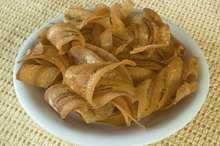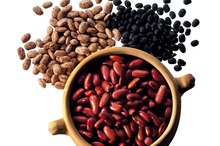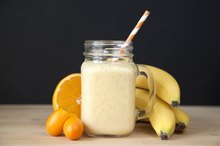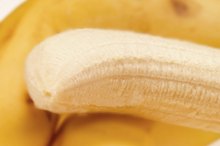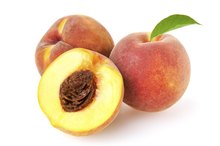Glycemic Index of Oranges
The glycemic index is a measure of how quickly the carbohydrates found in food provides the body with energy 1. Some foods release their energy quickly and are found on the high end of the glycemic index scale 1. Others release their energy slowly, over a longer period, and are found towards the lower end of the scale.
How the Glycemic Index Works
According to the Glycemic Index Database, foods with a GI value of 55 or less are classed as having a low GI 1. Low-GI foods release carbohydrate into the body at a steady rate and can help keep your blood sugar levels stable. Foods that fall between 56 and 69 on the scale are classed as medium GI and those over 70 are classed as high GI. High-GI foods release carbohydrate into the body very quickly and can result in disturbed blood sugar levels. Eat low-GI foods; too many high ones put you at risk of developing health problems.
- According to the Glycemic Index Database, foods with a GI value of 55 or less are classed as having a low GI 1.
- Low-GI foods release carbohydrate into the body at a steady rate and can help keep your blood sugar levels stable.
GI of Oranges
The Essential Guide to the Glycemic Index and Gluten Free Living
Learn More
According to the database, an orange has a glycemic index rating of 40 1. This puts it into the slow-release or low-GI category. You should be aware that different varieties of orange have slightly different GIs; however they all still fall within the low-GI group.
Orange Products
Orange juice has a GI value of 46 and is classed as having a low GI. Choose freshly squeezed orange juice over branded, unsweetened orange juices, because these have slightly higher GI values. Canned orange segments also fall within the low GI category. According to the database, canned orange and grapefruit segments in juice has a GI value of 53.
- Orange juice has a GI value of 46 and is classed as having a low GI.
Include Oranges
How to Dehydrate Bananas in a Food Dehydrator
Learn More
Oranges are easy to fit into your diet and eating just one will provide you with nearly your daily value of vitamin C. Avoid sticky fingers and take ready-peeled orange segments to work for a refreshing mid-afternoon snack or keep a jug of freshly squeezed orange juice in the refrigerator. Try spreading marmalade on your whole-grain toast in the morning.
Cooking with Oranges
Try to include oranges in your home cooking as much as possible. Oranges work well in sweet dishes, too. Try barbecuing or baking them, add them to crumbles and flans or make cakes, cookies and scones using the juice and zest.
Related Articles
References
- Glycemic Index: Home of the Glycemic Index
- Fruits and Veggies More Matters: Oranges: Nutrition, Selection, Storage
- Ojo O, Ojo OO, Adebowale F, Wang XH. The effect of dietary glycaemic index on glycaemia in patients with type 2 diabetes: A systematic review and meta-analysis of randomized controlled trials. Nutrients. 2018;10(3):373. Published 2018 Mar 19. doi:10.3390/nu10030373
- Glycemic Index and Diabetes. American Diabetes Association
- Search for the Glycemic Index. The University of Sydney
- Zeevi D, Korem T, Zmora N, et al. Personalized Nutrition by Prediction of Glycemic Responses. Cell. 2015;163(5):1079-1094. doi:10.1016/j.cell.2015.11.001+
- Sacks FM, Carey VJ, Anderson CA, et al. Effects of high vs low glycemic index of dietary carbohydrate on cardiovascular disease risk factors and insulin sensitivity: the OmniCarb randomized clinical trial. JAMA. 2014;312(23):2531-41. doi:10.1001/jama.2014.16658.
- Vega-lópez S, Venn BJ, Slavin JL. Relevance of the Glycemic Index and Glycemic Load for Body Weight, Diabetes, and Cardiovascular Disease. Nutrients. 2018;10(10). doi:10.3390/nu10101361
- Glycemic Index Database. University of Sydney. Updated October 13, 2020
- Eleazu C. O. (2016). The concept of low glycemic index and glycemic load foods as panacea for type 2 diabetes mellitus; prospects, challenges and solutions. African health sciences, 16(2), 468–479. doi:10.4314/ahs.v16i2.15
- Foster-Powell, Kaye, Holt, Susanna and Brand-Miller, Janette. "International table of glycemic index and glycemic load values: 2002." American Journal of Clinical Nutrition. 76,:1: 5-56 (2002).
- International Carbohydrate Quality Consortium, Jenkins, D. J., Willett, W. C., Astrup, A., Augustin, L. S., Baer-Sinnott, S., … Wolever, T. M. (2014). Glycaemic index: did Health Canada get it wrong? Position from the International Carbohydrate Quality Consortium (ICQC). The British journal of nutrition, 111(2), 380–382. doi:10.1017/S0007114513003905
- Leroux, MarcusFoster-Powell, Kaye, Holt, Susanna and Brand-Miller, Janette. "International Table of Glycemic Index and Glycemic Load Values: 2002." American Journal of Clinical Nutrition. Vol. 76, No. 1, 5-56, (2002).
- Lui, S., Willett, WC, et al. "A prospective study of dietary glycemic load, carbohydrate intake, and risk of coronary heart disease in US women.." American Journal of Clinical Nutrition. 71(6):1455-61. (2001).
- Mayer-Davis, E.J., Dhawan, A et al. "Towards understanding of glycaemic index and glycaemic load in habitual diet: associations with measures of glycaemia in the Insulin Resistance Atherosclerosis Study.." British Nutrition Journal. 95(2):397-405. (2006).
- Sacks, F. M., Carey, V. J., Anderson, C. A., Miller, E. R., 3rd, Copeland, T., Charleston, J., … Appel, L. J. (2014). Effects of high vs low glycemic index of dietary carbohydrate on cardiovascular disease risk factors and insulin sensitivity: the OmniCarb randomized clinical trial. JAMA, 312(23), 2531–2541. doi:10.1001/jama.2014.16658
- Salmeron, J, Manson, JE, et al. "Dietary fiber, glycemic load, and risk of non-insulin-dependent diabetes mellitus in women.." Journal of the American Medical Association. 12;277(6):472-7. (1997).
- Vega-López, S., Venn, B., & Slavin, J. (2018). Relevance of the Glycemic Index and Glycemic Load for Body Weight, Diabetes, and Cardiovascular Disease. Nutrients, 10(10), 1361. doi:10.3390/nu10101361
- Zeevi, D. Korem N. et al. Personalized Nutrition by Prediction of Glycemic ResponsesCell. 163:(5):1079-94. November 2015.
Writer Bio
Kim Ford has been writing professionally since 2008 with her work appearing in various publications and on websites, including "The News" and "Sportsister." She received a pre-entry certificate in newspaper journalism with a news associate/sports-beat emphasis from the National Council for the Training of Journalists.

